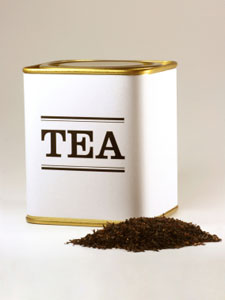FDA packaging requirements for tea


Navigating regulations is one of the more intimidating aspects of running a business. It should be relatively simple - and sometimes seems that way - but of course everything is written by lawyers or bureaucrats and the cost in time and money if you get anything wrong can be high. The Food and Drug Administration's labeling regulations are no exception. I've waded through these with two different companies now, and I can say with conviction that I hate the FDA's Code of Federal Regulations Title 21.
The purpose of this article is to provide a little guidance based on my research and experience. I am not a packaging attorney, so I must recommend for the record that you pass your plans for tea packaging by legal council before making a large investment. That said, I have talked with many attorneys and I did stay at a Holiday Inn Express last night so here goes:
The first question you need to answer is whether your packaging must be labeled for resale. There are three ways you can avoid the packaging regulations:
If, however, you package any food product ahead of time and have it sitting sealed on a counter, shelf or display for the customer to pick up and purchase, you need to understand and follow the regulations. So whether your teas are packaged and sealed professionally in a distribution facility or by a 17 year old sales associate, anything pre-packaged and displayed should be compliant with all federal regulations on food labeling.
These regulations are listed in detail online in the FDA's Code of Federal Regulations Title 21. But since I just spent the last few hours summarizing these for Adagio's design team, I figured I'd share my findings with you. There are 8 relevant sections that you should be aware of:
1. PRINCIPAL DISPLAY PANEL
Every package must have a "principal display panel" which is defined by 21 CFR § 101.1 as "… the part of the label that is most likely to be displayed, shown or examined under customary conditions of display for retail sale". This panel must be large enough to accommodate information that is required, such as the declaration of net quantity of contents (See, 21 CFR § 101.105) and the statement of identity (See, 21 CFR §§ 101.3). Packaged tea can have more than one principal display panel.
For the purpose of determining the appropriate font size of the required contents declaration, the "area of the principal display panel" must be ascertained. This is defined as the surface area of the side of the package that bears the required information. For rectangular containers, such as the boxes, tins or pouches used for tea, the area of the principal display panel is simply the height times the width of the side where the information will be displayed.
2. INFORMATION PANEL
The information panel is the part of the label of package that is immediately contiguous and to the right of the "principal display panel". 21 CFR § 101.2. Generally, this panel includes nutrition information (if necessary), an ingredient list, a statement of the name and address of the manufacturer, packer or distributor and country of origin markings, if the product is imported. Of course, some or all of the required information may be included on the principal display (front) panel. If any of the required information appears on the front panel, it does not need to be repeated on the information (right side) panel. Most of the information required is subject to a minimum type size requirement of one-sixteenth inch in height (ingredient list and name and address). Nutrition information (if required) is subject to different type size and presentation requirements.
3. IDENTITY STATEMENT
The principal display panel of a tea package is required to bear (as a primary feature) a statement of identity, generally consisting of the common or usual name of the tea. For our purposes, the particular blend or featured flavor of the tea would be sufficient, such as "ENGLISH BREAKFAST TEA", "CARAMEL BLACK TEA", "PEPPERMINT TEA", etc.
21 CFR § 101.3(2-3) requires the use of the "common or usual name of the food; or, in the absence thereof, an appropriately descriptive term, or when the nature of the food is obvious, a fanciful name commonly used by the public for such food.” I would interpret this to allow Identity Statements like "DARJEELING", "KEEMUN" or "DRAGONWELL" to be sufficient as stand-alone declarations. The purely arbitrary names like “BERRY BLAST”, or “WHITE CHRISTMAS” should be accompanied by a more descriptive Identity Statement like “FRUIT TEA”. In the case of flavored teas with single names, the tea type should be included in the name of the tea so as to guide the customer (in addition to the color scheme) and satisfy the packaging requirements for an accurate Identity Statement. For example, “ALMOND” should be named “ALMOND BLACK TEA”.
21 CFR § 101.3 requires that the identity statement appear on the front panel in bold type of a size "reasonably related to the most prominent type" used on the label and in lines generally parallel to the base of the package as it rests when displayed. In other words, it needs to be one of the biggest words on the panel and shouldn't be at a crazy angle.
21 CFR § 101.3(c) requires that, “Where a food is marketed in various optional forms (whole, slices, diced, etc.), the particular form shall be considered to be a necessary part of the statement of identity and shall be declared in letters of a type size bearing a reasonable relation to the size of the letters forming the other components of the statement of identity; except that if the optional form is visible through the container or is depicted by an appropriate vignette, the particular form need not be included in the statement.” I would interpret this to apply to tea bags vs. loose tea.
4. CONTENTS DECLARATION
Section 403(e)(2) of the Federal Food, Drug and Cosmetic Act (the "FDC Act") and 21 CFR § 101.105 require that the principal display panel bear a declaration of the net quantity of contents expressed in numerical count, weight, measure or a combination of numerical count and weight or measure. The declaration must: (1) appear as a distinct item on the principal display panel; (2) be separated, by at least a space equal to the height of the lettering used in the declaration, from other printed label information appearing above or below the declaration and, by at least a space equal to twice the width of the letter "N" of the style of type used in the quantity of contents statement, from other printed label information appearing to the left or right of the declaration; and (3) be placed within the bottom 30% of the area of the label panel in lines generally parallel to the base on which the package rests as it is designed to be displayed. (On packages having a principal display panel of five square inches or less, the requirement for placement within the bottom 30% does not apply.)
21 CFR § 101.105(3) requires that the term “net weight” shall be used when stating the net quantity of contents in terms of weight. This may be abbreviated but may not be omitted.
The type size of the contents declaration must comply with specifications that depend on the "area" of the "principal display panel" (See, No. 1 above regarding the "Principal Display Panel") as follows: (a) not less than one-sixteenth inch in height on packages the principal display panel of which has an area of five square inches or less; (b) not less than one-eighth inch in height on packages the principal display panel of which has an area of more than five but not more than 25 square inches.
Finally, the metric equivalent of the net quantity of contents that is declared by weight or volumetric measure is required to be included as a result of the American Technology Preeminence Act of 1991.
This section assumes that the declaration of quantity of contents (i.e. 10 TEA BAGS) will be the primary choice of the packager and allows for the combination of quantity and net weight for purposes of clarity, but does not speak to the use of only net weight without quantity where quantity would otherwise be the customary measure of the product. In the case of tea bags, I believe it is safe to assume most customers measure a package by the number of tea bags rather than the total weight of tea in the package. I have reviewed a number of the labels for teas that are prominent in the United States and determined that they usually declare the contents as a combination of numerical count AND net weight where applicable. I would recommend that the contents be declared on the front panels of the bagged tea products as follows: "10 TEA BAGS NET WEIGHT 0.9 OZ/25g e".
5. NUTRITION INFORMATION
All food labels are required to bear nutrition information presented in accordance with 21 CFR § 101.9, unless exempt. In general, foods that contain insignificant amounts per serving of all the nutrients (vitamins and minerals for which a daily value is established) and food components (calories, fat, carbohydrate, protein, etc.), as long as the food bears no nutrition claims or information on the label, in labeling (brochures, etc.) or in advertising. 21 CFR § 191.1(j)(4). The vast majority of teas and herbal teas are exempt from nutrition labeling on this basis, but many major tea brands include a "Nutrition Facts" panel, particularly those which have begun featuring the "antioxidant" properties of tea.
6. INGREDIENT LIST
Section 403(i)(2) of the FDC Act and 21 CFR § 101.4 require that the label of a food include a list of all ingredients that are declared by their common or usual names and in descending order of predominance by weight. The ingredient list must be included on the principal display panel or the information panel. An accurate identity statement on the front panel, such as "Black Tea", "Green Tea", etc., may be sufficient for single-ingredient tea or even a blend of black tea leaves so long as the only ingredient is Camellia Sinensis.
7. NAME OF MANUFACTURER/DISTRIBUTOR
Section 403(e)(1) of the FDC Act and 21 CFR § 101.5 require that the label of a food in package form specify conspicuously the name and place of business of the manufacturer, packer or distributor of the food. The statement of the place of business must include the name, street address, city, state and Zip Code. However, the street address may be omitted if it appears in a current city or phone directory.
When the food is not manufactured by the party whose name appears on the label, such as a U.S. distributor, that name must be qualified by a phrase that reveals the named party's relationship to the product, e.g., "Distributed By __________".
8. COUNTRY OF ORIGIN MARKINGS
Section 304 of the Tariff Act of 1930, 18 U.S.C. § 1304, and U.S. Customs and Border Protection regulations require conspicuous, legible and indelible country of origin markings that disclose such information to the ultimate purchaser, i.e., "Product of China" or "Made in China" on products of foreign origin. Generally, each time the container or holder (retail package) of foreign goods includes the name and address of the U.S. distributor, the name "United States" (or abbreviation) or any U.S. city or state, the country of origin's name must appear in close proximity and in comparable type size.
So there's my summary. Even this abbreviated version is painful, but not nearly as much so as wading through the regulations themselves... trust me! :)
Additional useful links:
Food Labeling Guide
Food Labeling and Nutrition Overview
Adagio Teas
Twitter: @AdagioRetail
